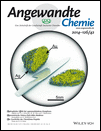Self-Oscillating Vesicles: Spontaneous Cyclic Structural Changes of Synthetic Diblock Copolymers†
This work was supported in part by Research Fellowships of the Japan Society for the Promotion of Science for Young Scientists (No.262029 to R. T. and No. 11J07791 to T. U.), and Grants-in-Aid for Scientific Research from the Ministry of Education (Japan) (No. 22245037 to R. Y.). We acknowledge Dr. Aya Mizutani Akimoto and Dr. Zulma Jiménez for helpful suggestions. We also thank the Research Hub for Advanced Nano Characterization at The University of Tokyo for TEM observation.
Abstract
A large variety of synthetic vesicles has been created for potential engineering applications and as model systems which mimic living organisms. In most cases, the structure is designed to be thermodynamically stable. However, mimicking dynamic behaviors of living vesicles still remains undeveloped. Herein, we present a synthetic vesicle which shows autonomous disintegration–reconstruction cycles without any external stimuli and which is similar to those in living organisms, such as in the nuclear envelope and synaptic vesicles. The vesicle is composed of a diblock copolymer which has a hydrophilic and a thermosensitive segment. The thermosensitive segment includes a redox moiety that acts as a catalyst for an oscillatory chemical reaction and also controls the aggregation temperature of vesicles. Furthermore, autonomous fusion of vesicles is also observed during the cycles.




